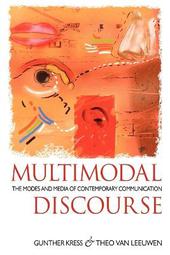
|
Multimodal Discourse
Paperback / softback
Main Details
| Title |
Multimodal Discourse
|
| Authors and Contributors |
By (author) Gunther Kress
|
|
By (author) Professor Theo van Leeuwen
|
| Physical Properties |
| Format:Paperback / softback | | Pages:160 | | Dimensions(mm): Height 234,Width 156 |
|
| ISBN/Barcode |
9780340608777
|
| Classifications | Dewey:302.2 |
|---|
| Audience | | Tertiary Education (US: College) | |
|---|
|
Publishing Details |
| Publisher |
Bloomsbury Publishing PLC
|
| Imprint |
Hodder Arnold
|
| Publication Date |
29 June 2001 |
| Publication Country |
United Kingdom
|
Description
"Multimodal Discourse" outlines a theory of communication for the age of interactive multimedia and multi-skilling. Just as the demarcation lines between specialized jobs are blurring in contemporary society, so are the demarcation lines between modes and media of communication. This requires a new way of thinking - it requires a practice in which designers can freely move between different modes and media, and a theory whose concepts and ideas can do the same. Drawing on a wide range of examples, Kress and Van Leeuwen sketch an approach to the idea of discourse in which colour plays a role equal to language, and show how two kinds of thought processes interact in the design and production of communicative messages, "design thinking" and "production thinking", the kind of thinking which occurs in direct interaction with the materials and media used. Above all the authors stress communicative practice and interactivity. Their question, throughout, is: how do people use communicative modes and media in actual, concrete, interactive instances of communicative practice?
Author Biography
Gunther Kress, IOE, UCL's Faculty of Education and Society, University College London, UK Theo Van Leeuwen, Faculty of Humanities and Social Sciences, University of Technology Sydney, Australia
Reviews`Multimodal Discourse is the theoretical browser we need to navigate the exuberant multimodality of the highly mediated owrld in which we live. For students and specialists in communication or semiotics, cultural studies or linguistics, graphic design or anthropology this is the foundationla theory of how meaning is made in this period of increasing semiotic fragmentation and cross-over.' * Ron Scollon, Professor of Linguistics, Georgetown *
|